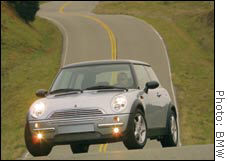NEW YORK (Money Magazine) -
Drive up in a Mini Cooper, and people's first reaction invariably is how cool and adorable it is. Second reaction: "Won't you be picking that thing out of a Hummer grille in an accident?"
 |
|
| Mini Cooper S |
There's no doubt that subcompact cars -- classified as 165 inches or less -- have the highest overall fatality rates. Federal data show that drivers of the tiniest cars are roughly twice as likely to die in car crashes as drivers of SUVs or mid-size cars -- 162 deaths for every 1 million registered small cars in 2002 vs. 90 for SUVs and 71 for mid-size vehicles.
Smaller cars simply have less structure around you to soak up the blow before passing it along to occupants.
"The laws of physics say you're going to be at a disadvantage," says Adrian Lund of the Insurance Institute for Highway Safety (IIHS). "But small cars don't automatically mean you're at a severe risk."
| Small cars
|

|
|
|
|
While larger cars remain the safest, Lund recommends that small-car fans seek the safest models overall (crash-test ratings are available online at nhtsa.gov or hwysafety.org). Today's smallest cars can offer surprisingly robust protection, thanks to sophisticated energy-absorbing structures, improved air bags and more.
The Mini Cooper is one of several models that earned a Best Pick from the IIHS for its crash-test performance, boosted by its half-dozen air bags. And rather than passively surrounding yourself in more armor than Fort Knox, advises a growing chorus of experts, you should consider what's called "active safety": the ability to avoid accidents in the first place by stopping quickly or taking evasive action without losing control.
Small sure has advantages here -- it's like the difference between a go-cart and a grocery cart. For all their size, pickups and SUVs have higher fatality rates in both single-vehicle accidents and rollovers than the tiniest cars do.
Another bright side is that highway fatality rates overall have plunged more than 70 percent since the mid-1960s, from 5.5 deaths for every 100 million miles of travel to 1.5 deaths. Vehicles have never been safer, period. But they'll always carry some level of risk. As Americans focus on weight, size and what-if scenarios, too many ignore the fact that how you drive -- wearing seat belts, not drinking, using caution -- still matters more than what you drive.

|

